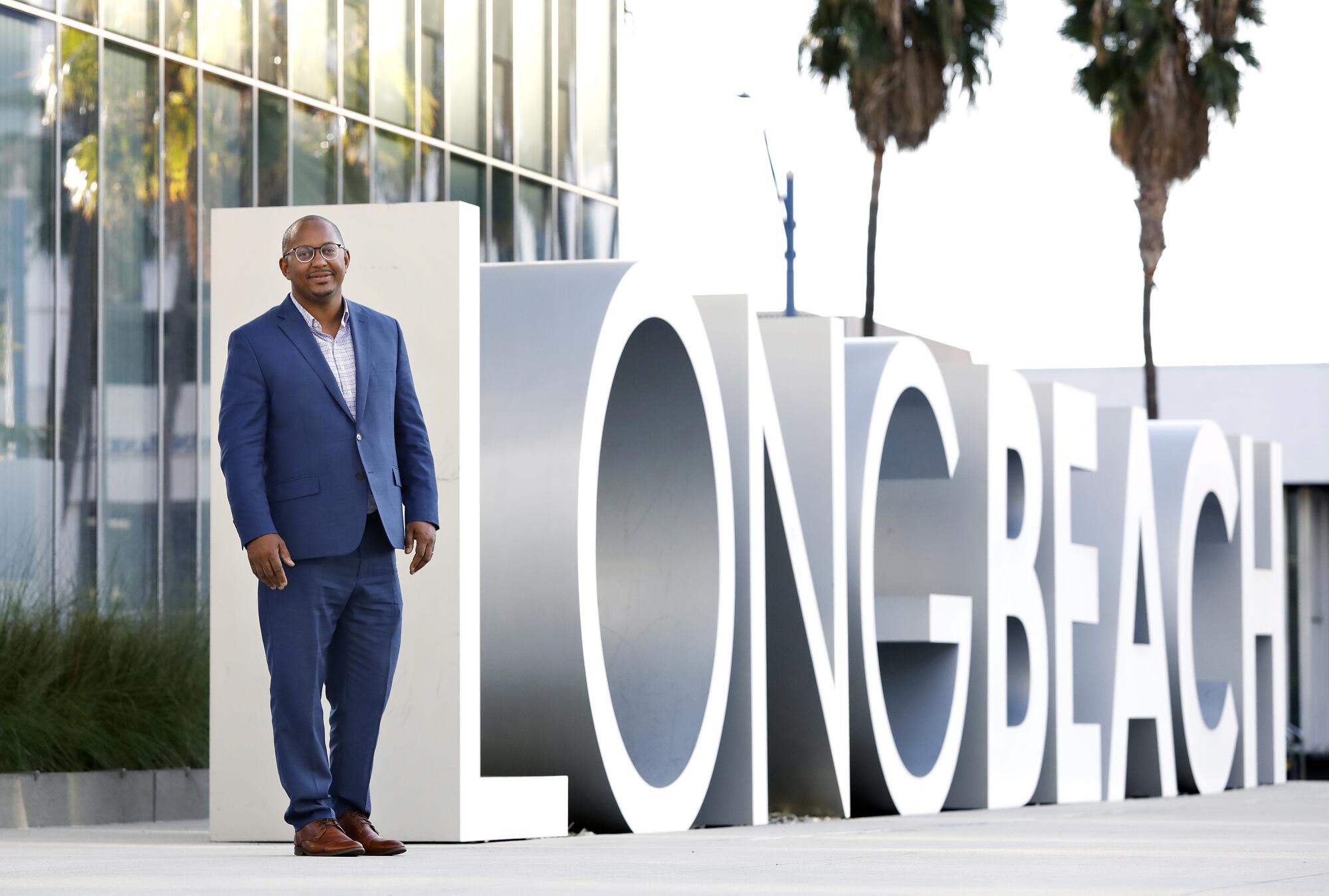
For a few shining years, which ended abruptly this spring, Long Beach looked like it might be a rare exception: a California city with a thriving and feisty media outlet.
The Long Beach Post had some of the best of 20th century print journalism, but delivered as an online alternative that featured a salty old columnist, sharp coverage of City Hall and investigations into some of the city’s leading institutions and stickiest social problems.
Over much of the last six years, LBPost.com became an essential stop for those intent on understanding California’s seventh-largest city. It nurtured a sense of place in a community long struggling to escape the shadow of Los Angeles.
But in recent months the popular website suffered a series of sharp setbacks — the exit of the Post’s principal financial backer, major staff reductions and a fierce rebellion by former employees who have started their own alternative news site. LBPost.com, the city’s media disrupter, has become the disrupted.
The result is that Long Beach — home of one of the nation’s busiest ports, the headquarters of the California State University system, a burgeoning aerospace technology industry, and the shopworn but still floating Queen Mary — has less in-depth civic news, neighborhood features and public engagement.
Local journalism strangled by shaky finances has become the norm across America. But the disruption feels particularly painful in this city of 459,000, because locals had become accustomed to more in the short years that the Post supplanted the local newspaper, the Long Beach Press-Telegram, as the most-read outlet in town.
The Web metrics analyst Similarweb showed that LBPost.com had 451,000 visits a month when it was thriving four years ago, about 100,000 more than the Press-Telegram.
New amendments to the California Journalism Preservation Act aim to make it more like a similar law in Canada.
“It’s hard to know exactly what’s lost because you don’t know what you don’t know,” said Barbara Kingsley-Wilson, a lecturer on journalism and advisor to the student newspaper at Cal State Long Beach. “What we know for sure is that there are not as many people shining a light on this city.”

The situation has become alarming enough that Long Beach Mayor Rex Richardson has called for a media “incubator” to help provide logistical and financial backing to journalism. Richardson said in an interview that an independent group, not the city, should launch such an initiative. “It’s becoming a news desert,” Richardson said, “for those neighborhood-level things that people really care about.”
California news publishers and Big Tech companies appear to be inching toward compromise on legislation requiring digital platforms to pay news outlets.
In today’s desiccated media landscape, it’s hard to imagine that Long Beach once supported two daily newspapers — the afternoon Press-Telegram and the morning Independent. The Independent closed down in 1981, while the Press-Telegram moved to morning publication as the only daily in the city.
The P-T and Independent proved so omnipresent in city affairs a half-century ago that a Los Angeles Times investigation concluded that the papers had overstepped ethical boundaries, directing city officials on public policy and covering up scandals such as the routine drunkenness of the city manager.
But the near-monopoly on local advertising once held by newspapers evaporated with the advent of the internet in the 1990s. That sapped the money that once allowed the Press-Telegram to support a staff of more than 200 journalists.
In the 1980s and early ’90s, The Times operated a three-person bureau in Long Beach, but the paper’s suburban staffing was shut down well before the dawn of the new millennium. The local news environment got an unexpected boost in 2013 when the then-owner of the Orange County Register opened a daily edition for the city. Launched with great fanfare, the Long Beach Register lasted just over a year before closing.


The Long Beach Post was another matter. It arrived in 2007, claiming it could fill the news gaps. Shaun Lumachi, a policy consultant for chambers of commerce, founded the Post along with Robert Garcia, then a university instructor, who would go on to be Long Beach’s mayor and now the city’s representative in the U.S. House.
Lumachi’s death in a 2011 car accident and Garcia’s political ascension led to the sale of the upstart website to Cindy Allen, a former Long Beach police officer who had opened a public relations firm. The outlet gained a foothold under Allen but never quite found a consistent business model to pay the bills.
A new era began in 2018, when businessman John Molina bought the Post. Molina’s father, C. David Molina, founded a healthcare company in the 1980s with a single harbor-area clinic and built Molina Healthcare Inc. into a national giant with more than 5 million customers.
The Long Beach Register is closing, the latest in a series of cutbacks by Orange County Register parent company Freedom Communications.
Molina’s investment, estimated at nearly $10 million over more than five years, allowed the Post to expand its staff to 26, by far the biggest news operation in the city. Some reporters, particularly Jeremiah Dobruck, were given the time to launch deep investigations. A former newsroom leader from the L.A. Times, Joel Sappell, helped guide some of the most ambitious work.
That created high-impact stories, including projects showing that the city’s police disproportionately pulled over Black drivers; the Convention and Visitors Bureau spent lavishly, with little accountability; and private operators allowed Long Beach’s No. 1 landmark, the Queen Mary ocean liner, to fall into disrepair.
The Post also took a hard look at the city’s homelessness crisis, delivered lively food, arts and entertainment coverage, and featured the comforting presence of columnist Tim Grobaty, who grew to prominence during a long career at the Press-Telegram.
But the Post also discovered another truth visited on many other media outlets that have relied on wealthy investors: Their benefactor’s patience with financial losses is not infinite.
Molina, 60, and his brother J. Mario Molina, came from a family that grew wealthy by providing affordable healthcare, mostly to the poor. Though the brothers were forced out of leadership roles at Molina Healthcare in 2017, the family remains a substantial presence in their native Long Beach. The former P-T news headquarters downtown now provides office space for Molina Healthcare, one of the city’s major employers.
John Molina threw himself into investments in treasured community assets, like Music Tastes Good, a music festival, and Community Hospital, a financially struggling enterprise with seismic-safety challenges that served the city’s east side.
But neither of those ambitious investments succeeded in the long run. In 2019, Molina spun off the popular festival to a new operator, who has not restarted the event. And the hospital never reopened as the full-service facility residents clamored for; Molina leased the property to another business, which hopes to open a more specialized facility offering supportive housing and recuperative care.
The Long Beach Media Guild announced Friday that nine Long Beach Post staffers received layoff notices after moving to unionize and going on strike.
Critics see his investment in LBPost.com in a similar vein: however well-intentioned, ultimately locked in an economic quagmire. Despite the estimated $10 million Molina invested, the expanded staff and the multiple awards for coverage, the site never found enough readers or advertisers to break even.
Kevin Flores, a journalist who co-founded the Long Beach-based online news site Forthe, wrote a story about the Post’s struggles. He faults Molina for stopping his subsidy of the Post before the site’s leaders found a more stable business model.
“The fact is that John didn’t create any type of structure, during the years that he was funding them, to plan for this unmooring,” Flores said.
But others wonder if anyone could find a path to sustainability with a staff of more than two dozen. Allen, the one-time Post owner and now a City Council member, called it pointless to blame Molina. She recalled how she even dipped into her retirement savings to cover the Post’s payroll.
“They had a lot of freedom to do what they wanted with all those employees,” Allen said, “but it was unsustainable.”
The tech giant said it would limit some users’ access on its search engine to articles from California news outlets, in response to proposed legislation to help publishers.
Brandon Dowling, chief of staff of Molina’s Pacific6 investment partnership, said that the businessman was managing a number of other investments, including restoration of two historic Long Beach landmarks — the Breakers Hotel and the Ocean Center apartments. Pacific6 pulled back from the Long Beach Post after “we started to see the resources that were going to be needed to get those [other] projects across the finish line,” Dowling said.
Molina rejected the idea that he had not done enough to prepare the Post for success after his withdrawal. Others familiar with the Post’s transition to nonprofit status last year say Molina and his siblings gave $325,000 to help pay for the shift. Molina declined to discuss financial details, but said he also provided legal and business advisors and allowed the Post to keep all revenue from ads, subscriptions and other sources.

Melissa Evans volunteered to lead the Post into a new, nonprofit era. A veteran reporter and editor at the Press-Telegram and other publications, Evans had no experience on the business side of media.
When she examined the books of the outlet for the first time last year, she found a yawning shortfall. The website had more than $200,000 in monthly expenses, the vast majority going to pay employees, she said. The Post managed to bring in only about one-third of that amount in revenue, including subscriptions from about 2,000 readers and advertising, said Gwen Shaffer, a professor in the Cal State Long Beach journalism department and Post board member.
“It comes down to basic math,” Shaffer said. New Chief Executive Evans and the three-member board of directors believed staff had to be cut for the LBPost to survive.
The Post had already been trimmed to 17 staffers, from its high of more than two dozen, when Evans told her employees in March that more cuts were coming. What followed was a series of tense and emotional confrontations between the no-nonsense newswoman, 48, and her staff of mostly younger journalists, who pleaded for Evans and her board to explore other options.
The employees quickly agreed, en masse, that they should join the Communications Workers of America, the union that represents many journalists, including those at The Times.
The reporting staff had become disillusioned with Evans, with many saying they thought she had become autocratic. The Post’s board and Evans’ fans in Long Beach said she only took the strong actions needed to save the city’s top publication.
One of her initiatives was to explore a partnership with the American Journalism Project, or AJP, a Washington, D.C.-based nonprofit that provides funding and business guidance to many of the journalism startups nationally that are trying to fill in the gaps left by shrinking newspapers.
But staffers, including feature writer and editor Kat Schuster, voiced concern that the Post would be giving up its local focus on Long Beach and potentially be forced to cover neighboring cities. That’s a claim Evans and others rejected, noting that AJP-supported websites are left under local editorial control.
The possible partnership with the Washington-based nonprofit was put on hold because of the turmoil within the Post.
The March session between the journalists and Evans grew tense. Jason Ruiz, a city government reporter, walked out. Most of the staff followed him.
Evans called nine Post employees the next day to say they had been laid off. The dissident employees declared a strike and charged that workers had been added to the layoff list after they became leaders of the unionization drive.
Evans and the Post board made the case that the cuts, though deeply painful, could not be avoided. They scoffed at the notion that anything more than economics drove the cuts.

The dissident workers started their own alternative website, Long Beach Watchdog.
In a dramatic gesture, Evans said she and the board would resign and “hand over” the Long Beach news website to the striking workers. The workers demanded specifics about the condition of the site, to assess what they would be getting. The talks devolved into more bickering.
Data from Similarweb shows the upstart Watchdog had just 20,000 visits in May, a fraction of the Post’s 186,000 visits. But that puts the once-dominant Post behind the Press-Telegram and only at about one-third of its peak audience of a few years ago.
The Watchdog journalists occasionally gather at a collective workspace to try to conjure a newsroom vibe. They pledge to keep working, mostly for free, while they max out their credit cards and take part-time work to pay the bills.
Meanwhile, the Post’s skeletal crew operates out of a mostly empty office with a sweeping view of the port.
Evans says the six-person crew soon to be on board — though less than one-quarter the size of the Post’s peak staffing — will be supportable with a combination of major gifts, memberships, corporate support and grants.
“Any newsroom that leans too heavily on the generosity of one individual, like we did with John, is likely going to either end like the OC Weekly,” the Orange County publication that folded in 2019, Evans said, “or like us, where you have to scrape and fight and find a way to make it work on your own.”
More to Read
Sign up for Essential California
The most important California stories and recommendations in your inbox every morning.
You may occasionally receive promotional content from the Los Angeles Times.
















